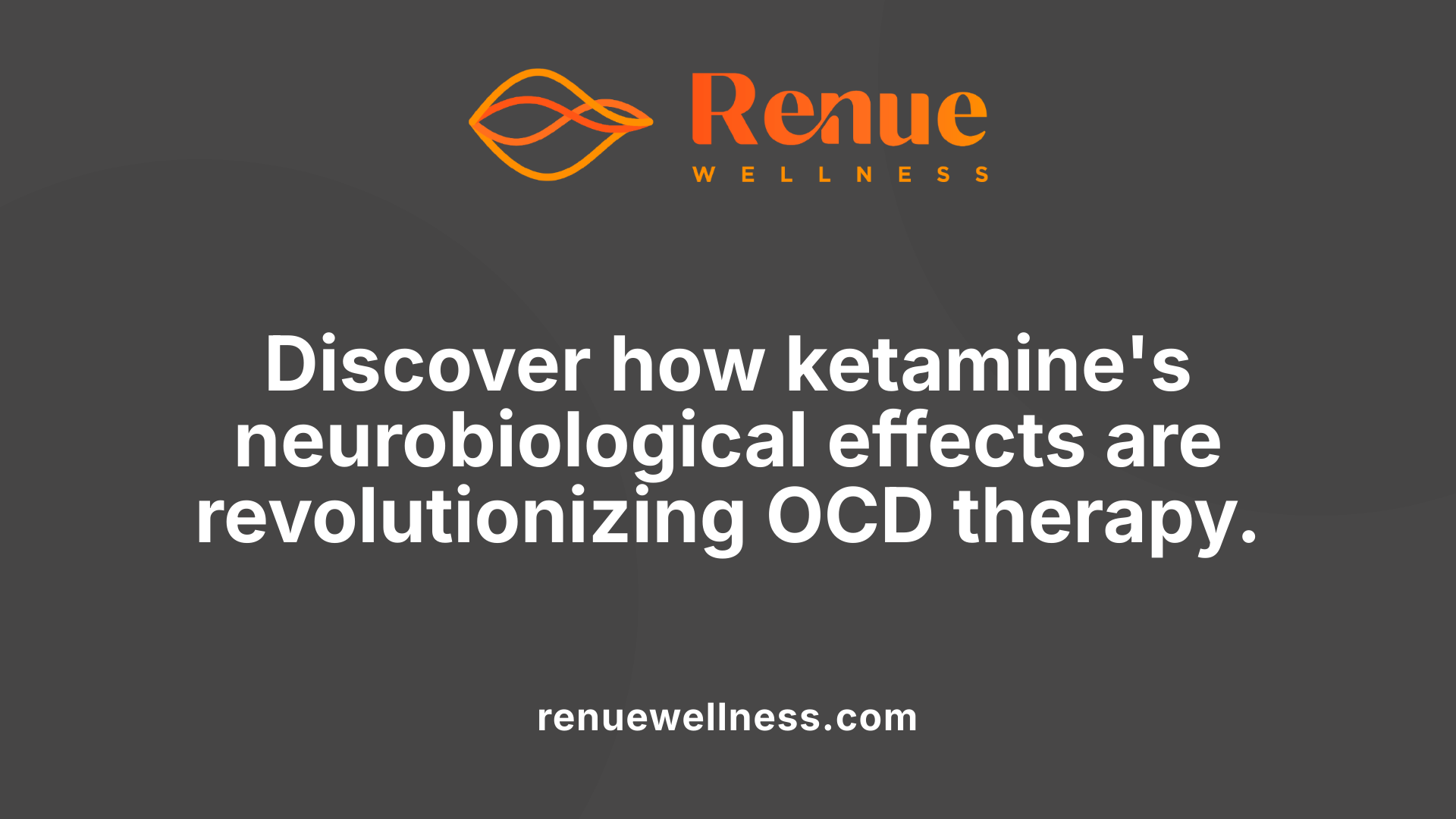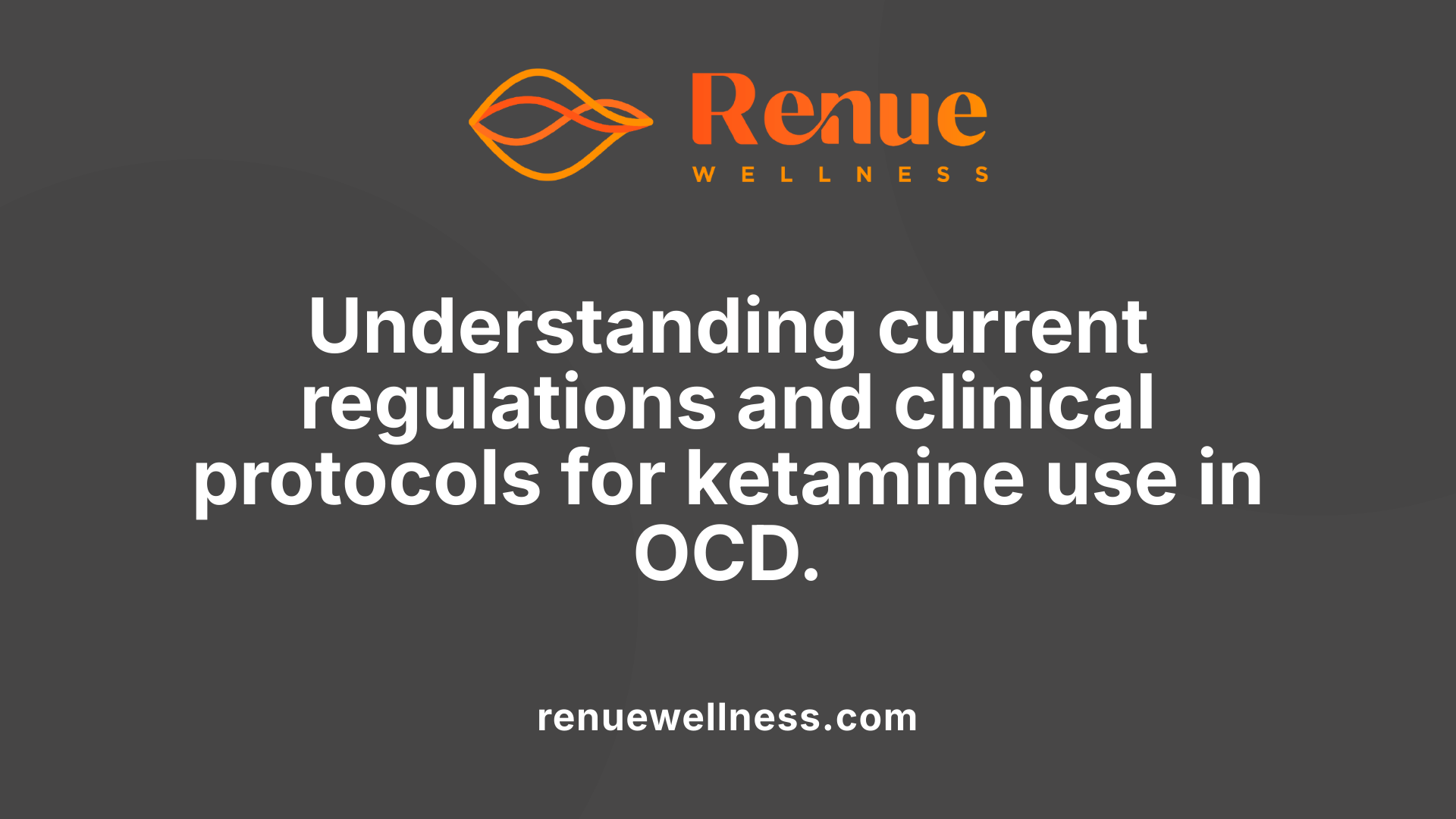OCD Awareness Week: How Clinical Ketamine Fits Into Your Journey


August 1, 2025
Understanding the Role of Ketamine in OCD Care
Obsessive-Compulsive Disorder (OCD) affects approximately 2.3% of the population, often beginning around age 19.5. Despite traditional treatments such as cognitive-behavioral therapy (notably Exposure and Response Prevention) and SSRIs, many individuals continue to struggle with persistent symptoms. During OCD Awareness Week, it's crucial to highlight innovative treatments like ketamine therapy, which show promise for rapid symptom relief, especially in treatment-resistant cases. This article explores how clinical ketamine fits into the evolving landscape of OCD management, the science behind its effects, safety considerations, and how it might shape future neuroscience-based treatments.
What is Ketamine and Its Role in OCD Treatment?

How does ketamine work as an NMDA receptor antagonist in OCD?
Ketamine, traditionally used as an anesthetic, is gaining attention for its potential to treat obsessive-compulsive disorder (OCD), especially in cases where traditional therapies have failed. Its primary action involves blocking N-methyl-D-aspartate (NMDA) receptors, a type of glutamate receptor in the brain. By inhibiting these receptors, ketamine alters the glutamate pathways, which are crucial for neural communication and plasticity.
This modulation leads to an increase in glutamate levels in the prefrontal cortex, fostering a cascade of neurobiological effects. Elevated glutamate activity facilitated by ketamine promotes rapid synaptic changes and strengthens neural circuits that have become rigid or maladaptive in OCD. This process helps to disrupt the entrenched patterns of intrusive thoughts and compulsive behaviors that characterize OCD.
Ketamine in Neuroscience and Future OCD Treatments

How does ketamine fit into emerging neuroscience approaches for OCD treatment?
Ketamine represents a significant advance within the evolving landscape of neuroscience-based treatments for obsessive-compulsive disorder (OCD). Unlike traditional therapies, which primarily target serotonin pathways, ketamine exerts its effects through modulation of the brain's glutamate system. This approach shifts the focus toward neural circuit dysfunctions, which are increasingly recognized as core to OCD pathology.
The mechanism involves ketamine's ability to increase glutamate transmission, leading to rapid neuroplastic changes within key brain regions. Clinical trials, such as those spearheaded by Carolyn Rodriguez at Stanford University, have highlighted ketamine’s potential to produce immediate symptom relief. This short-term efficacy is thought to stem from its impact on circuit pathways involving the anterior cingulate cortex (ACC), a region implicated in error detection, conflict monitoring, and emotional regulation. In OCD, abnormal activity often occurs within these circuits, contributing to intrusive thoughts and compulsive behaviors.
Research further suggests that ketamine triggers neurobiological processes like synaptogenesis—the formation of new synaptic connections—by activating molecular pathways involving mechanistic target of rapamycin (mTOR) and brain-derived neurotrophic factor (BDNF). These pathways are critical for cellular growth, plasticity, and long-term functional improvements.
Emerging neuroimaging studies aim to clarify how ketamine influences neural circuits. Findings indicate that ketamine may normalize hyperactivity in the ACC and other associated regions, thereby reducing symptoms. The ability of ketamine to promote extinction learning, a process vital for unlearning compulsive behaviors, points to its potential as an adjunct to therapies like exposure and response prevention (ERP).
Overall, ketamine’s integration into the neuroscience framework focuses on its capacity to rapidly remodel dysfunctional neural circuits. This approach highlights a shift toward understanding OCD as a circuit disorder, where restoring balance within specific brain networks can lead to substantial therapeutic gains. Researchers continue to investigate how ketamine’s modulation of receptor activity, synaptic strength, and neurotrophic factors can be harnessed for safer, faster-acting interventions that target the underlying neurobiology of OCD.
FDA Approval Status and Clinical Practices

Is ketamine FDA-approved for OCD treatment, and what are the current clinical practices?
As of October 2023, ketamine has not received formal FDA approval for the treatment of obsessive-compulsive disorder (OCD). Its FDA approval remains limited to use as an anesthetic agent, which includes induction and maintenance of anesthesia during surgical procedures. The application of ketamine for mental health conditions, particularly OCD, falls under off-label use, meaning it is administered based on clinical judgment without specific FDA approval for this indication.
Despite the lack of official approval, some clinics and practitioners have adopted ketamine as an experimental or adjunctive treatment for severe or treatment-resistant OCD. These clinical settings typically operate under carefully designed protocols that emphasize safety and monitoring. Protocols often include thorough medical assessments prior to treatment, to evaluate suitability and mitigate risks.
Most treatment protocols involve supervised infusions, generally administered in a clinical environment with trained healthcare professionals present. This supervision ensures vital signs such as blood pressure, heart rate, and oxygen saturation are continuously monitored during the infusion to manage potential side effects like transient increases in blood pressure or dissociative experiences.
In terms of formulations and routes of administration, clinics may use intravenous (IV) infusion, intranasal sprays, or sublingual lozenges, depending on the specific protocol. Importantly, these practices are typically conducted within a research or clinical setting, often resembling a therapeutic session rather than standard outpatient treatment.
The regulatory landscape continues to evolve. The FDA is actively reviewing ketamine and its derivatives, such as esketamine (Spravato), which has been approved specifically for treatment-resistant depression under a Risk Evaluation and Mitigation Strategy (REMS). However, esketamine’s approval does not extend to OCD. The ongoing research aims to better understand ketamine's safety profile, optimal dosing, long-term effects, and mechanisms of action, which could pave the way for formal approval in the future.
Most insurance companies currently do not reimburse for ketamine treatments for OCD, considering it off-label. Consequently, patients often bear the expense out of pocket, underscoring the importance of treatment within approved research protocols or specialized clinics.
Clinicians practicing ketamine therapy adhere to safety standards established for its use in anesthesia, with particular precautions for psychiatric applications. These include pre-treatment assessments, patient education, emergency preparedness, and post-treatment observation.
In summary, while ketamine is not specifically approved by the FDA for OCD, its off-label use within controlled clinical environments persists, driven by promising preliminary results and ongoing research. Patients considering this treatment should seek qualified providers, understand the regulatory status, and ensure proper safety measures are in place.
Safety Considerations and Expected Outcomes of Ketamine Therapy

What are the safety considerations and possible outcomes of ketamine therapy for OCD?
Ketamine therapy for obsessive-compulsive disorder (OCD) offers promising results, but it requires careful medical supervision to ensure safety. As an emerging treatment, ketamine is administered in controlled clinical settings where professionals monitor patients closely throughout the infusion process.
Potential side effects of ketamine include temporary dissociation, spikes in blood pressure, and cognitive changes. Dissociation, which involves feelings of disconnection from reality or oneself, is a common short-term effect that typically resolves shortly after treatment. Elevated blood pressure and increased heart rate can occur during infusions, making cardiovascular monitoring essential, especially for individuals with pre-existing conditions.
Other transient effects may include dizziness, nausea, headaches, or feelings of disorientation. These symptoms often diminish quickly, particularly when patients are well-prepared and monitored. Proper guidance and post-treatment care, like staying hydrated and resting, can mitigate adverse experiences.
Clinical trials have shown that ketamine can lead to rapid symptom relief in treatment-resistant OCD cases. Some patients experience significant reductions in intrusive thoughts and compulsive behaviors within hours of treatment, with effects lasting from days to several weeks. In studies, approximately 60% of participants reported substantial symptom improvement after low-dose infusions. These positive outcomes are often enhanced by combining ketamine with psychotherapy and integration practices.
While many patients find ketamine to be effective and tolerable, responses vary. Not everyone experiences the same degree or duration of relief. Ongoing research continues to refine dosing protocols, explore long-term safety, and clarify which patient groups are most likely to benefit.
It is crucial to note that, despite its promising efficacy, ketamine is not yet FDA-approved specifically for OCD. Its off-label use is generally restricted to clinical trial settings or specialized treatment clinics. The unregulated proliferation of clinics offering ketamine infusions poses safety concerns, emphasizing the importance of professional oversight.
In conclusion, ketamine therapy has demonstrated significant potential in alleviating OCD symptoms rapidly. Safe administration relies on comprehensive medical supervision, proper patient selection, and diligent post-treatment support. Continued research aims to optimize treatment protocols, understand long-term effects, and establish standardized guidelines to maximize benefits and minimize risks.
Treatment Protocols and Patient Experience
What does the initial assessment, infusion schedule, and post-treatment integration look like?
The journey into ketamine-assisted therapy begins with a comprehensive medical assessment. Healthcare providers evaluate the patient’s physical and mental health history to ensure safety and determine the most appropriate treatment plan. The standard protocol typically involves administering a series of six ketamine infusions spread over three to six weeks. These infusions are carefully scheduled to optimize therapeutic outcomes and monitor the patient’s response.
Following the infusion sessions, patients engage in an integration phase. This crucial period involves reflecting on the experience and incorporating insights gained during the sessions into daily life. Integration is often supported by therapies such as yoga, journaling, meditation, and listening to music, which help solidify new mental pathways and promote emotional well-being.
How is the treatment environment designed for patient comfort and safety?
Patients undergoing ketamine therapy are provided with a serene and calming environment. The setting is often adorned with ambient lighting and soothing decor to create a sense of tranquility. Ambient music is played softly in the background to foster relaxation and ease any anxiety.
Throughout the infusion, vital signs—including blood pressure, heart rate, and oxygen levels—are meticulously monitored. This ensures the patient’s safety and helps clinicians respond promptly to any physical reactions. The goal is to make the experience as comfortable and safe as possible, minimizing physical discomfort and psychological stress.
What practices are incorporated to help maximize therapeutic benefits?
To support long-lasting change, clinicians incorporate various practices into the post-infusion phase. Yoga and meditation are popular choices to enhance relaxation and promote mindfulness. Journaling allows patients to document their experiences, insights, and emotional shifts, serving as a valuable tool for reflection.
Listening to music continues to be an integral part of the therapy, aiding emotional processing and making the experience more immersive. These activities help patients process their journey, facilitate emotional regulation, and foster a sense of personal growth.
Summarizing the patient experience
Overall, ketamine-assisted therapy involves a carefully crafted blend of medical precision and nurturing environment. The infusion process is supported by safety measures and complemented by holistic practices designed to empower patients. This integrated approach aims to harness ketamine’s neuroplasticity effects, help break dysfunctional thought patterns, and support mental health recovery.
| Aspect | Details | Additional Notes |
|---|---|---|
| Initial assessment | Medical history, mental health evaluation | Ensures safety and personalized plan |
| Infusion schedule | 6 sessions over 3-6 weeks | Customizable based on response |
| Environment | Serene, calming, ambient music | Enhances relaxation |
| Monitoring | Vital signs monitored continuously | Maintains safety |
| Post-treatment practices | Yoga, journaling, meditation, music | Supports integration and lasting change |
| Follow-up | Booster sessions, therapy | Ensures ongoing support |
This carefully structured approach aims to maximize the therapeutic potential of ketamine, helping individuals achieve meaningful and sustainable mental health improvements.
Beyond the Infusion: Post-Treatment and Maintenance Strategies

Follow-up Support, Booster Sessions, and Therapy Integration
After completing initial ketamine-assisted therapy, maintaining its benefits involves ongoing support and carefully planned follow-up. Many clinics recommend booster sessions, which are additional infusions or treatments designed to reinforce the neuroplastic changes initiated during the initial therapy. These sessions are usually spaced weeks or months apart, depending on individual needs.
In addition to supplemental infusions, integrating therapy practices into daily life is essential. Integration therapy helps patients process their experiences, insights, and emotional shifts gained from ketamine sessions. Common approaches include guided journaling to reflect on emotional insights, engaging in mindfulness meditation to enhance awareness, and listening to calming music to foster relaxation and emotional processing.
These processes aim to solidify new neural pathways and thought patterns, reducing the likelihood of relapse and supporting long-term mental health improvements.
The Broader Impact and Future of Ketamine in OCD Management
What research is underway, including large clinical trials and neuroimaging studies?
Current investigations into ketamine's role in treating OCD are expanding rapidly. Large-scale clinical trials, such as those sponsored by institutions like Stanford University, are designed to explore ketamine's efficacy, safety, and underlying mechanisms at a deeper level. These studies often employ neuroimaging techniques, including fMRI and EEG, to observe changes in brain activity, particularly in circuits involved in OCD, such as the cortico-striatal-thalamo-cortical loop.
For example, a Phase 2 randomized, quadruple-blind trial at Stanford compares ketamine with placebo (midazolam) to measure symptom reduction via the Yale-Brown Obsessive Compulsive Scale (YBOCS). These trials aim to elucidate how ketamine influences glutamate levels, neural connectivity, and brain network functioning, providing critical insights into its rapid therapeutic effects.
Moreover, research efforts are exploring the neurobiological impact of ketamine metabolites like hydroxynorketamine, which may contribute to antidepressant and anti-obsessional effects without adverse side effects. These studies are vital for understanding how ketamine induces neuroplasticity and disrupts the rigid neural pathways characteristic of OCD.
What potential does ketamine have for long-term symptom management?
While the immediate benefits of ketamine are well-documented, researchers are increasingly focusing on its potential for sustained relief of OCD symptoms. Evidence suggests that ketamine can foster neuroplasticity, creating new neural pathways that break the cycle of intrusive thoughts and compulsive behaviors.
Protocols involving repeated sessions and post-treatment integrative therapy, such as yoga and meditation, aim to maintain these neural changes. Follow-up support like booster infusions and ongoing psychotherapy are key components in prolonging benefits.
Emerging data indicates that, with appropriate long-term strategies, ketamine could serve as part of a broader treatment plan to manage symptoms over months or even years, especially when traditional therapies have failed. Nonetheless, the necessity for more longitudinal research remains, to understand optimal dosing intervals, maintenance treatments, and the full scope of long-term safety.
What are the emerging alternatives and complementary therapies like psychedelics and neuromodulation?
Beyond ketamine, a spectrum of innovative therapies is gaining attention for OCD and other treatment-resistant conditions. Psychedelics such as psilocybin and MDMA are being studied for their potential to promote neuroplasticity, reduce symptoms rapidly, and produce lasting effects.
Psilocybin, for instance, activates serotonin 2A receptors, stimulating neurogenesis and reconnecting disrupted neural circuits. Early trials have shown promising results for depression, anxiety, and substance use disorders, with some exploring applications for OCD.
Similarly, MDMA-assisted psychotherapy is showing high remission rates for PTSD, which shares neurobiological similarities with OCD. Its ability to diminish fear responses and facilitate emotional processing makes it a compelling complementary treatment.
In tandem with psychedelics, neuromodulation techniques like transcranial magnetic stimulation (TMS) and deep brain stimulation (DBS) are under active investigation. These approaches aim to directly alter dysfunctional brain activity associated with OCD.
Overview of current research and future directions
| Area of Focus | Description | Significance |
|---|---|---|
| Large clinical trials | Expanding use of randomized controlled trials | Confirm efficacy, safety, and mechanisms |
| Neuroimaging studies | Visualizing brain changes post-treatment | Uncover biological pathways involved |
| Metabolite research | Focusing on compounds like hydroxynorketamine | Minimize side effects, enhance benefits |
| Long-term management | Developing protocols for sustained relief | Improve quality of life and reduce relapse |
| Alternative therapies | Psychedelics and neuromodulation | Broaden treatment options |
| Integrated approaches | Combining ketamine with psychotherapy and family support | Maximize therapeutic gains |
Concluding insights
The future of ketamine therapy in OCD management is promising yet complex. Ongoing research aims to deepen our understanding of its mechanisms, optimize delivery protocols, and explore complementary treatments. Integrating neuroimaging, molecular biology, and clinical insights will be crucial to developing personalized, effective long-term management strategies.
As the field advances, ethical considerations, safety protocols, and comprehensive practitioner training will ensure responsible application of these innovative therapies. With continued research, ketamine and related compounds could significantly transform the landscape of OCD treatment, offering hope to those who have not benefited from traditional approaches.
Shaping the Future of OCD Care
As research advances and clinical practices evolve, ketamine therapy stands as a promising frontier in the treatment of OCD. Its rapid action and neuroplasticity-enhancing effects may reshape how clinicians approach resistant cases, complement existing therapies, and usher in a new era of neuroscience-guided mental health care. During OCD Awareness Week, recognizing these innovations highlights not only current treatments but also the ongoing pursuit of hope and healing for those living with OCD.
References
- Ketamine for OCD - Nushama
- The pros and cons of ketamine for obsessive compulsive disorder ...
- Ketamine-assisted psychotherapy in adolescents with multiple ...
- Ketamine as a Treatment for OCD: New Research & Key Insights
- OCD and Ketamine | Wu Tsai Neurosciences Institute
- What to Do After Ketamine Treatment: Aftercare Tips From Our Care ...
- A Cohort-Based Case Report: The Impact of Ketamine-Assisted ...
- The Better U Process - Ketamine Therapy
Recent Posts
Conditions Treated
AnxietyDepressionOCDPTSDPostpartum DepressionPain ManagementSubstance AbuseSuicidal IdeationOur Location


